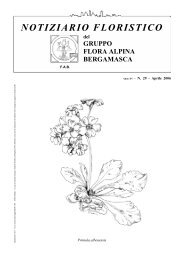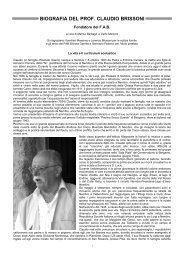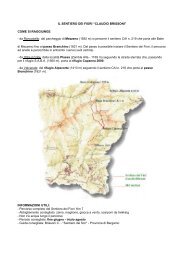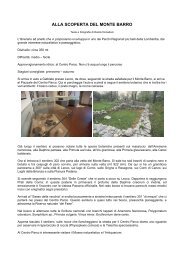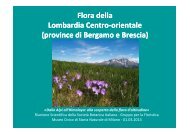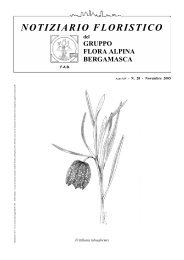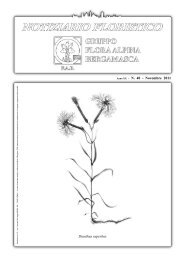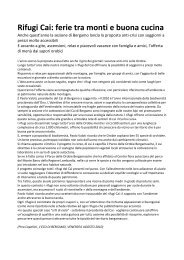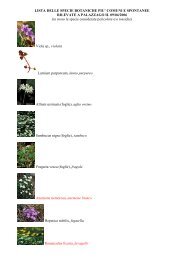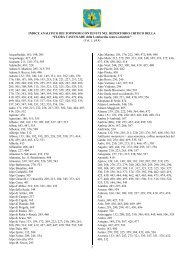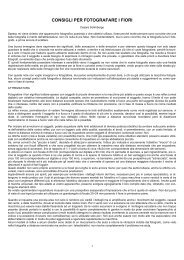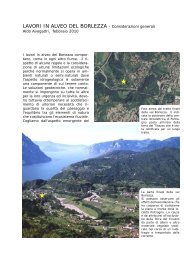IBI 40 Supplemento 1 (2008) - Gruppo Flora Alpina Bergamasca
IBI 40 Supplemento 1 (2008) - Gruppo Flora Alpina Bergamasca
IBI 40 Supplemento 1 (2008) - Gruppo Flora Alpina Bergamasca
You also want an ePaper? Increase the reach of your titles
YUMPU automatically turns print PDFs into web optimized ePapers that Google loves.
INFORMATORE BOTANICO ITALIANO, <strong>40</strong> SUPPL. 1, <strong>2008</strong><br />
<strong>Flora</strong> da conservare: implementazione delle categorie e dei criteri IUCN (2001) per la redazione di nuove Liste Rosse<br />
7<br />
Abstract<br />
In several European countries national plant red list<br />
and red data books, compiled according to the 2001<br />
IUCN criteria, have been recently published or are<br />
being prepared. The production of a global European<br />
red list is also a priority that would fill an existing gap<br />
and would meet many requests in this sense coming<br />
from the plant conservation community and would<br />
deliver to the EU an important tool to implement a<br />
consistent, European-wide plant conservation action.<br />
In this scenario the Italian Botanical Society is contributing<br />
with the pilot project here presented, to<br />
stimulate the interest of the relevant national authorities<br />
in the production of a new updated Italian red<br />
list. This is doubtless an ambitious and demanding<br />
task, considering that the Italian botanical diversity<br />
accounts for approx. 7,000 taxa of vascular plants,<br />
1,100 taxa of bryophytes, 2,200 taxa of lichens and<br />
4,200 taxa of macro fungi (Basidiomycetes). This<br />
pilot project was launched at the end of 2005 by the<br />
relevant working groups of the Italian Botanical<br />
Society and focused on <strong>40</strong> taxa, chosen to be representative<br />
of the Italian flora, including different taxonomic,<br />
phytogeographical and ecological groups<br />
(widely and narrowly distributed, occurring at the<br />
edge of their distribution area, in wet, marines or<br />
mountain habitats). In this process the current Italian<br />
phytogeographical subdivisions did not prove to be<br />
adequate, needing a revision, taking into account the<br />
recent advances in the plant distribution data, vegetation<br />
science and biogeography.<br />
The pilot project instantly proved to be a success,<br />
considering the enthusiastic support from many<br />
Italian botanists, willing to work together contributing<br />
towards this important goal, even in the absence<br />
of specifically dedicated funds. This was a clear evidence<br />
that the expertise and the capacity to deliver a<br />
new Italian red list is present and that such a project<br />
is totally realistic in its aims and in its implementation.<br />
It is particularly encouraging to note that accurate<br />
data on the distribution of threatened plants<br />
(required to apply the 2001 IUCN criteria), can be<br />
collated from literature, herbaria and contributions<br />
from the very active community of amateur<br />
botanists. However these data are usually dispersed<br />
and difficult to source and assemble; they also need<br />
to be updated and validated in the field. This latter<br />
activity could be carried out in partnership with protected<br />
areas that should include such activities in<br />
their management plans. A critical point of the project<br />
was detected in the very few data available on<br />
demography, reproduction biology and genetic<br />
structure of the populations, that are essential to<br />
apply the PVA (Population Viability Analysis),<br />
requested for criterion E.<br />
Out of the <strong>40</strong> taxa considered 38 belong to a threat<br />
category (either CR, EN or VU), showing how the<br />
Italian flora is severely endangered, mainly because of<br />
habitat destruction in the many spreading building<br />
sites across the country and because of changes in<br />
land use, such as those related to tourist development.<br />
The occurrence of growing sites in protected<br />
area is not necessarily a safety haven per se, as very<br />
often specific management plans are required for the<br />
target species conservation and integrating in situ<br />
and ex situ activities, and these very rarely are in<br />
operation.<br />
It is hoped that this pilot project will open the way<br />
to the production of an updated red list for the<br />
whole of Italy, supported by the relevant national<br />
authorities that are in charge of biodiversity conservation<br />
and plant conservation in particular.<br />
Riassunto<br />
In Europa diversi paesi hanno già realizzato o stanno<br />
lavorando a nuove Liste Rosse per la flora a livello<br />
nazionale, utilizzando i nuovi criteri e le categorie di<br />
minaccia pubblicati nel 2001 dalla IUCN. Allo stesso<br />
tempo, si sta profilando la necessità di giungere<br />
alla redazione di Liste Rosse su base continentale, per<br />
permettere all’Unione Europea di portare avanti<br />
politiche più coerenti nella conservazione della natura.<br />
In questo quadro, l’Italia sta cercando di dare il<br />
proprio contributo, con nuove iniziative che partono<br />
dalla Società Botanica Italiana (S.B.I.), nella speranza<br />
anche di coinvolgere in questo percorso le autorità<br />
politiche nazionali. Del resto l’impresa di redigere<br />
per l’Italia nuove Liste Rosse e tenerle aggiornate è<br />
assai impegnativa, data l’elevata diversità vegetale di<br />
questa nazione. La <strong>Flora</strong> Italiana si contraddistingue<br />
per l’elevato numero di specie, stimato attualmente<br />
in circa 7000 taxa di piante vascolari, 1100 briofite,<br />
2200 licheni e 4200 Basidiomiceti; cifre che corrispondono<br />
a una parte consistente della ricchezza floristica<br />
europea. Pertanto, alcuni Gruppi di Lavoro<br />
interni alla S.B.I., sul finire del 2005, hanno deciso<br />
di intraprendere un’azione pilota, realizzando la valutazione<br />
dello stato di minaccia, con i criteri IUCN<br />
del 2001, relativamente ad un campione di <strong>40</strong> taxa.<br />
Tali taxa sono differenziati sia sul piano tassonomico<br />
che fitogeografico (taxa con areali di varia estensione<br />
e taxa al limite di areale) che, infine, ecologico (zone



